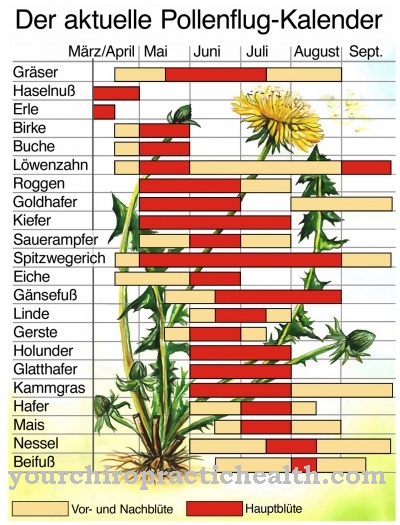This is different from the dust lung in miners Bird holder lung largely unknown as a disease. It owes its name to the fact that people who come into regular contact with birds often suffer from it.
What is a bird keeper's lung?
The Bird holder lung is sometimes also called Pigeon fancier disease or Aviculture lung designated. In medical terminology it is called exogenous allergic alveolitis or is one of several forms of these. In the bird keeper's lung, the alveoli, i.e. the alveoli, are inflamed as a result of an allergic reaction.
The allergic reaction generally arises from the inhalation of fine dust, such as chemical substances or organic dusts. In the specific case of the bird keeper's lung, however, the allergic reaction and the associated inflammation are caused by the inhalation of animal proteins that occur in the dust raised by the droppings and feathers of birds.
This distinguishes it from similar diseases such as chemical worker lung, farmer's lung or humidifier lung, which are also categorized as exogenous allergic alveolitis, but have different causes. A bird keeper's lung can be acute or insidious and can be chronic.
causes
The real cause of a bird keeper's lung is an immune reaction in the lungs. This is caused by the inhalation of certain allergens that are found in the dust caused by the droppings and feathers of birds. If this dust is then inhaled, it gets into the lungs and with it certain animal proteins. There these trigger a so-called immune complex reaction of type III, which in turn results in an inflammatory reaction of the lung tissue.
The immune complex reaction of type III falsely activates the so-called complement system which, as part of the human immune system, serves to switch off cellular antigens such as bacteria. In this way, the organism is informed that there is a danger to the lungs and reacts with inflammation of the tissue, which in turn brings further symptoms.
Symptoms, ailments & signs
In the acute form of the bird owner's lung, the first symptoms usually appear 4 to 8 hours after the first contact with the allergens. Symptoms are similar to pneumonia and range from a cough, sometimes accompanied by sputum, to a fever and difficulty breathing, and even a high pulse. The symptoms usually subside within a few days after the contact is ended.
The creeping, chronic form of the bird keeper's lungs, on the other hand, is noticeable through more flu-like symptoms. In addition to body aches and fatigue, this can lead to weight loss and a general feeling of weakness and exhaustion. In contrast to the acute illness, the symptoms then appear in a weakened form and in bursts.
Continuous contact with the allergen can lead to fibrosis, i.e. a lasting change in the lung tissue, which in turn can lead to chronic coughing, shortness of breath, even with normal stress, and heart problems.
Diagnosis & course of disease
The diagnosis of a bird keeper's lung is usually made by excluding other possible clinical pictures and various examinations. Just the information that the person concerned has frequent contact with birds usually leads the attending physician on the right track. Listening to the lungs, chest X-rays and the detection of specific antibodies against the inhaled animal protein in the body usually make the diagnosis clear.
Complications
A bird keeper's lung leads to serious complaints and must always be treated. In many cases, however, those affected suffer from a significantly reduced and restricted life expectancy. The symptoms can vary and depend on the severity of the disease.
However, they are very similar to the symptoms of pneumonia, so that patients suffer from a cough or sputum. Fever or severe breathing difficulties also occur through the bird keeper's lungs and have a very negative effect on the everyday life of the person concerned. Usually, the symptoms are aggravated by contact with the allergen.
If contact is avoided, the symptoms usually disappear after a few days.If the bird keeper's lung is not treated, it can lead to significant breathing problems even under normal stress. There is a strong tiredness and exhaustion of the person concerned.
Since a direct and causal treatment of the bird keeper's lung is not possible, only the individual symptoms can be treated. As a rule, there are no particular complications. However, a completely positive course of the disease is not achieved.
When should you go to the doctor?
A visit to a doctor is always necessary at the Vogelhalterunge. As a rule, the earlier the doctor is consulted, the better the further course of this disease is. If there is no treatment, in the worst case scenario the affected person can die. A doctor should be contacted about this disease if the person affected very often has inflammation of the lungs.
In most cases, a strong cough and persistent breathing difficulties are also very common. The everyday life and resilience of the patient are also considerably restricted by the bird keeper's lungs. It is not uncommon for permanent fatigue to occur and patients to suffer from symptoms of the flu and continue to experience weight loss. If these symptoms occur for no particular reason and do not go away on their own, you must definitely see a doctor.
As a rule, the bird keeper's lung can be recognized by a general practitioner or an ENT doctor. However, further treatment depends largely on the severity of the symptoms, so that no general prediction can be made about success. In many cases, however, the patient's life expectancy is reduced by this disease.
Treatment & Therapy
The most important thing in the treatment of a bird keeper's lung is the immediate and permanent avoidance of contact with the allergen, i.e. the dust of the feces and feathers of birds. People who are professionally involved in keeping birds may then have to give up or change their profession.
Successful treatment is almost impossible without renouncing contact with the allergen. In the case of a chronic course, the administration of glucocorticoids is the drug of choice. These steroid hormones, which are produced in the adrenal cortex, inhibit the inflammatory reactions in the lungs and thus also the symptoms that occur.
Severe forms of chronic bird keeper's lung can be treated with immunosuppressants. These inhibit the normal function of the immune system and can thus also prevent the type III immune complex reaction responsible for the bird keeper's lungs and their inflammatory reactions. Even an irreparable change in the lung tissue that is already developing can be slowed down in its development.
You can find your medication here
➔ Medicines against coughs and coldsprevention
The development of a bird keeper's lung can only be prevented to the extent that contact with birds is completely avoided. However, since it is impossible to know with certainty that the disease will break out before the first contact with birds or before the first symptoms appear, such a safety measure is greatly exaggerated. Another possible prevention tactic would be to avoid inhaling the bird dust, which in practice could prove extremely difficult.
The bird keeper's lung is common in people who work with birds. It is a reportable occupational disease because of its potentially serious health consequences. But hobby breeders can also get sick from it and should take the first symptoms seriously, as long-term contact can have dire consequences for the lungs and heart.
Aftercare
This disorder posed a challenge to the immune system, especially if the patient had extensive contact with birds and / or the diagnosis was made late. Even if the animals have been given away and the bed linen changed, it is possible that traces of the allergens can still be found in the household. For this reason, particular attention should be paid to hygiene and cleanliness in the area around the person concerned, at least in the first year of follow-up care for a bird keeper's lung.
If possible, professional cleaning is recommended. In order to support the immune system and prevent chronic lung damage, it helps patients if they adhere to a healthy lifestyle and do not smoke, but instead spend a lot of time in nature and in the fresh air. It is also advisable to refrain from alcohol and sporting activities, as far as the general physical condition allows.
Of course, a healthy lifestyle also includes a diet rich in vitamins, adequate sleep and as little stress as possible. Eliminating and detoxifying measures are also helpful in the aftercare of a bird keeper's lung. Doctors working in naturopathic medicine or non-medical practitioners can recommend appropriate means here.
Even saunas, steam baths or sweaty work or sport detoxify the organism. Fruits and vegetables rich in water also have a detoxifying effect. Such elimination processes should be supported by the patient by drinking one and a half to two liters of water daily.
You can do that yourself
If a bird keeper's lung has been diagnosed, contact with the allergen must be completely avoided. Bird owners and breeders may have to give up their animals to prevent the disease from progressing. In addition, duvets and feather pillows should be removed from the apartment. To avoid mold, potted plants, aquariums and food prone to mold must also be disposed of.
The bird breeder's lung is notifiable. Affected persons quickly contact the competent authority as well as persons who may also have come into contact with the animals. The allergy can be treated well as long as the patient complies with the measures mentioned and informs the doctor of any unusual symptoms. Difficulty breathing and skin changes that require medical treatment are typical. Suitable self-help measures are sport and lots of exercise in the fresh air.
After the diagnosis, patients should take it easy until the symptoms have subsided. This can take a few weeks to months. If cardiovascular symptoms occur in connection with the disease, the responsible internist or allergist must be consulted. The administration of glucocorticoids can be supported by regular fluid intake and the creation of a medication diary in which any side effects and interactions are noted.
























.jpg)


